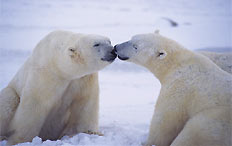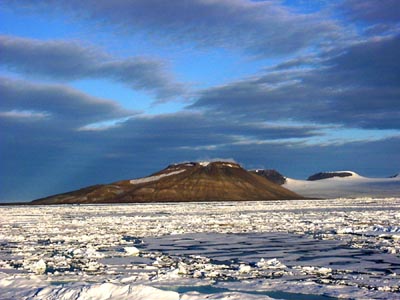Joint Projects
Project 3
Study of radiative and thermal physical properties of the ice-snow cover (drifting and landfast ice, glaciers) in the Spitsbergen archipelago area
Grantee: O.M. Andreev O.M., AARI
PI from AARI: Dr B.V. Ivanov
Since the quality of one or another parameterization is based on the results of full-scale experiments, it is necessary to increase the volume of experimental data on a regular basis. For arrangement of such observations, it is necessary to take into account that a full-scale experiment will allow us both qualitatively and quantitatively to describe the small-scale (sub-grid) processes occurring in the snow-ice cover and subsequently express them or their influence through the main variables of the model used. The snow cover of glaciers and tundra similar to the snow cover of drifting and landfast ice in fjords and ambient waters of the Spitsbergen archipelago present a convenient research site for obtaining full-scale information necessary for evolving detailed parameterizations of the melting processes.
The results obtained from the snow-ice cover studies of the Spitsbergen archipelago and the adjoining water areas can be considered common with some probability both for the Arctic Basin in general and for the Arctic Seas in particular. This is especially important for the areas of the Barents and Kara Seas where rapid development of offshore oil and gas fields began during the last few years.
Project 4
Comparative analysis of climatic variability of Shpitsbergen Archipelago and North - European region on a basis of weather stations network data
Grantee: Anna Terebenko, St.Petersburg State University
PI from AARI: Dr Pavel Svyaschennikov
PI from NPI: Dr Jack Kohler
The main stages of research
1. To carry out analysis if studies of climatic variability characteristics of Spitsbergen Archipelago's atmosphere based on literature sources.
2. To create climatic data base on a basis of observations of weather stations network of the region under study (Spitsbergen Archipelago, Franz Josef Land, northern part of Europe. Originating data base will cover the following information: coordinates of station, height above sea level, average monthly air temperature, pressure, relative humidity, amount of total and lower cloudiness, amount of atmospheric precipitation.
3. To carry out comparative analysis of interrelation of separate elements of climatic variability in different parts of studied region.
Analysis of climactic variability shall include:
a) Critical quality control of meteorological observations.
b) Study of long-period tendencies of change of climate with the help of evaluation of linear trends of air temperature and precipitation during all period of instrumental control as well as evaluation of modem changes.
c) Evaluations of spatial interrelation of change of climate in different parts of studies region with the help of mutual correlation analysis of fields of air temperatures, pressure and atmospheric precipitation taking into consideration seasonal changes.
d) Study of frequency structure of variability with the help of spectral analysis.
e) Study of time scales of spatial interrelation of variability in different parts of studied region with the help of mutual spectral analysis, decomposition of fields by natural orthogonal functions as well as with the se of singular decomposition of matrixes.
f) Evaluation of laws of separate meteo elements distribution with the help of delta-like functions method. A existence of two and more modes of probability density function could be interpreted as appearance of local non-uniqueness of the climate.
Project 5
Long-period variability of thermohaline structure and circulation of water in Fram Strait and Euro-Arctic Seas
Grantee: Andrey Rubchenia, AARI
PI from AARI: Prof. Dr Leonid Timokhov
Recent investigations (Quadfasel, 1987; Aagaard et al., 1985, 1987; Morison, 1991) show importance of studying of this region. It determines necessity of studying of processes proceeding there, the analysis of seasonal, interannual and multi-year changes, and, as a result of prospective researches, creation of phenomenological model of thermohaline structures of ocean water masses from Fram Strait to the Franz Josef Land.
The main goals of this project are:
Determination of climatic changes of water circulation in the Euro-Arctic seas and in Fram Strait
Obtaining characteristics of the temporal variability of three-dimensional thermohaline structure of the ocean in the Arctic Basin from Fram Strait to the Franz Josef Land.
Estimates of the water exchange between the Arctic and the North-European basins at different levels from the surface to the bottom over the period 1950 to 2000 years.
To achieve the understanding of the Greenland Sea hydrological and climatic system dynamics long-term spatially distributed observational data will be required. Available database includes thermohaline data for the 1950-2000 year period.
Such a complicated distribution of waters in the Greenland Sea determined methodology of investigation of seasonal and interannual variability of the thermohaline characteristics. Realization of the objective expert and statistical analysis of the available data for reception of continuous time series of the oceanographic characteristics necessary for realization of the further analysis is planned.
The goal of investigations is to determine temporal-spatial structure of the waters masses in the Fram Strait and determination of climatic changes of water circulation from the surface to bottom in the investigated region. If there are any trends, complex analysis of thermohaline data will be able to help us in elucidating the nature of these changes.
The Greenland Sea Basin plays an important role in water exchange between Arctic and the Atlantic basins of ocean (Nagurny, 1985). This water exchange will be estimated. The analysis of these results can help us with understanding of the processes occurring in this region.






